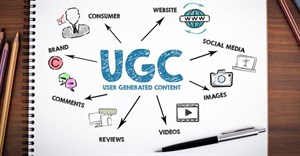Trending
Elections 2024
Jobs
- Creative/Conceptual Copywriter Cape Town
- Sales Consultant Nelspruit
- Copywriter and Content Producer Cape Town
- Marketing Account Executive Johannesburg
- Marketing Manager George
- Senior Digital Marketing Communications Specialist Cape Town
- Marketing Channel Manager George
- Head of Marketing Johannesburg
- Corporate Fundraising Officer Cape Town
- Account Executive Cape Town
Why email should form a key part of your e-commerce marketing strategy

As one of South Africa’s most successful digital agencies, TDMC has launched more than 200 e-commerce stores, helping some of South Africa’s largest retailers and entrepreneurs build profitable online retail channels, with a solid email marketing strategy playing a key role in this success. The agency is one of only four accredited Shopify Expert Partners in SA and is also a Google Premier Partner and Meta Business Partner. Here, Shepard outlines why email should be prioritised when setting out your e-commerce marketing strategy, and why direct ownership of your customer data can empower your brand and increase revenue.
Q: How has email marketing evolved and are SA brands and agencies keeping up with the trends?
Many SA brands and agencies are lagging behind their overseas counterparts and aren’t using email as effectively as they should. I believe this is an area that sets TDMC apart – our team is committed to always staying up to date with international trends which allows us to implement these learnings with our customers.
Over the past few years, personalisation, automation, and integration have changed the face of email marketing around the world, and when used effectively can transform the whole customer journey, from interest through to purchase. Brands are using customer data and audience segmentation to tailor email content based on individual preferences, as well as using previous purchase history to personalise emails.
Email marketing automation tools have completely evolved in the last couple of years, and users can utilise Klaviyo or Mailchimp to send relevant emails based on triggers such as user or product engagement. For example, “We saw you looking at this…” or “We saw you browsing…”. These automated emails have become massively successful sales conversion tools – their role is to bring customers back to store. The same applies to cart abandonment automated emails – “We see you didn’t complete your purchase…” – that are sent to customers who have placed an item in their cart but haven’t completed the sale.
Also, automation saves time and money because these emails are based off triggers and take pressure off your team. While it takes time and effort to set these emails up, once they are established, they only require updating every three to six months. Most crucially, around 70% of email revenue comes from automation – so if you are not leaning into this it is a massive missed opportunity.
Integration gives you a single view of your customer. With the right tools and strategy in place you can integrate email marketing across all your channels – social media, WhatsApp, email etc – giving the user a true omnichannel experience. Ultimately the goal is to give your customer the most seamless and personalised experience possible no matter where or when they engage with your brand.
Q: What advice do you give clients looking to develop a subscriber base?
Most importantly you need to provide value to customers who subscribe to your emails – there is no point in simply getting people to sign up so that you can get their email address. You need to use that email address wisely by giving the customer – or potential customer – information that is relevant and valuable. Remember, by signing up they are giving you consent to communicate with them, and it is crucial that you don’t disrespect or abuse that relationship of trust.
First off, brands need to dismiss the outdated notion that people receive too many emails and that emails from brands go unread. To maximise your open rate, you need to listen to customers and where they are in their consumer journey. This means brands need to have a preference page where customers can opt into information or topics that are relevant to them.
As their database grows brands can segment their audience based on their behaviours: where they shopped, demographics etc. When segmentation is done effectively it results in higher engagement, click-through and spend, while at the same time saving brands money because mails are highly relevant and targeted, which cuts down on the cost per send.
Q: What’s a ‘decent’ subscriber base?
Some of our brands have got a database of 20,000, and others in the millions. It isn’t about vanity numbers, instead we like to emphasise the quality of a brand’s relationship with their subscribers rather than making high subscriber numbers the goal. It is more important to have a smaller number of subscribers on your database with a high engagement rate, rather than an impressive number of subscribers with little to no engagement.
Q: What advice would you give an established brand who has neglected email marketing but would now like to incorporate it in their marketing strategy?
We cannot over-emphasise the importance of first party data – brands need to own this data themselves and have their customer information at their fingertips. This will become even more important with expected changes in data privacy and who brands can target. We expect targeting capability will diminish over the next few years, especially if third party data capture falls away, so brands need to take back control and ensure they own that data themselves.
The first step is to build you database by getting customers to sign up to receive emails from you. Next it is important to segment that database so that customers are receiving relevant, useful, and personal brand info. The key to successful email marketing is automation, so this needs to be built in across all your channels.
What gaps does email marketing fill in that social media can’t?
CS: Social media can’t greet the customer – it isn’t a personalised experience. Because you can’t segment your social media audience as narrowly, your messaging can’t be as targeted as it can be via mail. With email you are speaking directly to customers who have opted in, which means you know their preferences and have insights into their online customer journey so you can create a distinct message and build a campaign around that.
Also, if you load your customer data onto Facebook, for example, often only a small percentage will match. Social media relies on the algorithm and user behaviour to identify your potential customers and target audience, whereas with an email sign-up your customer – or potential future customer – has already raised their hand and asked your brand to engage with them. You’re meeting them much further along on their consumer journey, which greatly improves your chances of converting that relationship into a sale.
- Retailer insights: Why Shopify makes sense16 Apr 15:29
- Prioritise client and team relationships, and other valuable lessons from a media director26 Mar 16:14
- TDMC named Google Premier Partner for 3rd consecutive year29 Feb 08:44
- How to maintain a startup culture when your business grows20 Feb 10:52
- The power of curiosity – and other lessons I’ve learnt07 Feb 09:47




















